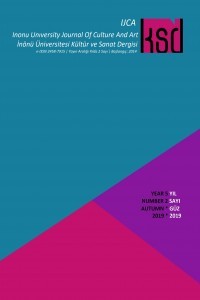GAUGUIN’İN BAŞYAPITI: NEREDEN GELİYORUZ? NEYİZ? NEREYE GİDİYORUZ?
Paris doğumlu Paul Gauguin resimsel arayışları için çıktığı yolculukta uygar dünyaya ait tüm sorumluluklarını geride bırakarak Güney Pasifik’in yerlileri arasında yaşamıştır. Resimlerinin ana konusu, tercih ettiği yeni yaşam tarzının tasviridir ve bu tasvirler sanatçının sembolik anlatımıyla birlikte doğa-insan uyumunu öne çıkarırken sanatçının ilkel yaşayışla şekillenen duygularının da yansımasıdır. Bu araştırmada analizi yapılan “Nereden Geliyoruz? Neyiz? Nereye Gidiyoruz?” isimli eser sembolik anlatımıyla insanın yeryüzündeki konumunu, doğasını ve bu ikisi arasındaki çelişkileri anlatmaktadır. Bu anlatım esnasında uygar ve ilkel dünyaya yapılan göndermelerin ortaya çıkarılması ve eserin isminde yer alan sorulardan yola çıkarak Gauguin’in dünyaya bakışının gözler önüne serilmesi amaçlanmaktadır. Bu amaç doğrultusunda literatür taraması yapılarak sanatçı ve eser hakkında bilgiler toplanmış, bu bilgiler ışığında resimde kullanılan öğelere yüklenen sembolik anlamlar çözümlenerek eserin bütünde verdiği mesaj ortaya çıkarılmıştır. Bu mesaj; sanatçının dünyaya bakışının bir yansıması, ilkel yaşayışa ait iddialı söylemiyle de bir yaşam felsefesinin ilanıdır.
Anahtar Kelimeler:
Gauguin, Nereden Geliyoruz, Neyiz, Nereye Gidiyoruz, Eser Analizi
THE MASTERPIECE OF GAUGUİN: WHERE DO WE COME FROM? WHAT ARE WE? WHERE ARE WE GOING?
Paul Gauguin was born in Paris and during the journey that he set on for his pictorial quests; he left behind all his responsibilities in the civilized world and lived amongst the natives of South Pacific. The main subject of his pictures is the description of his newly preferred lifestyle and while these descriptions bring the harmony between humans & nature to the forefront by a symbolic portrayal of the artist, they also represent a reflection of the artist's emotions that were shaped by a primitive life. The work named "Where Do We Come From?, What Are We?, Where Are We Going", which we analyze in this research, portrays the status and nature of humans on the globe and the discrepancies between them with a symbolic language. This portrayal aims at discovering the attributes made to the civilized & primitive world and portraying Gauguin's view of the world by relying on the questions included in the title of his Work. Information about the artist have been gathered for this purpose by making a literature review, the symbolic meanings attributed to the objects, which were used in the pictures, were analyzed in the light of this information and the message given by the Work's entirety has been revealed. This message is a reflection of the artist's view of the World and the declaration of his life philosophy through his assertive discourse about primitive life.
Keywords:
Gauguin, Where Do We Come From, What Are We, Where Are We Going, Analysis of Artwork,
___
- Cassou, J. 1999. Sembolizm Sanat Ansiklopedisi. (Ö. İnce, & İ. Usmanbaş, Çev.) İstanbul: Remzi Kitabevi.
- Ferguson, G. 1954. Signs & Symbols in Christian Art. New York: Oxford University Press.
- Gamboni, D. 2014. Paul Gauguin : The Mysterious Centre of Thought. (C. Miller, Çev.) London: Reaktion Books.
- Gauguin, P. 1922. The Letters of Paul Gauguin. (R. Pielkovo, Çev.) New York: Dodd, Mead and Company.
- Gauguin, P. 1972. Noa Noa. (K. Kandaş, Çev.) İstanbul: Yankı Yayınları.
- Gauguin, P. 2001. Mahrem Günlük. İstanbul: İthaki Yayınları.
- Klein, J., & Takahata, N. 2002. Where Do We Come From? The Molecular Evidence for Human Descent. New York: Springer.
- Kutsal Kitap. 2014. Kitabı Mukaddes Şirketi ile Yeni Yaşam Yayınları.
- Thompson, J. 2014. Modern Resim Nasıl Okunur. (F. C. Çulcu, Çev.) İstanbul: Hayalperest Yayınevi.
- Turani, A. 2010. Dünya Sanat Tarihi. istanbul: Remzi Kitabevi.
- Walter, I. F. 1997. Paul Gauguin 1848-1903: Yeryüzü Cennetinin Peşinde. (A. Antmen, Çev.) İstanbul: ABC Kitabevi A.Ş.
- Werness, H. B. 2006. Continuum Encyclopedia of Animal Symbolism in World Art. New York: Continuum International Publishing Group.
- Yılmaz, M. 2013. Modernden Postmoderne Sanat. Ütopya Yayınevi: Ankara.
- ISSN: 2458-7915
- Başlangıç: 2014
- Yayıncı: İnönü Üniversitesi
Sayıdaki Diğer Makaleler
ÜLKÜ MECMUASI (1933-1950) MÜZİK YAZILARI BİBLİYOGRAFİSİ
JOEL-PETER WITKIN’İN FOTOĞRAFLARINDA YENİDEN ÜRETİM
BASKIRESİM’DE DENEYSEL ARAYIŞLAR VE ATÖLYE 17
GAUGUIN’İN BAŞYAPITI: NEREDEN GELİYORUZ? NEYİZ? NEREYE GİDİYORUZ?
KEMAN, PİYANO VE VİYOLONSEL “INO-2” İÇİN BİR ROTARU ÜÇLÜ NEO-FOLKLOR TARZI
TÜRK MÜZİĞİNDE TRANSPOZE (ŞED/GÖÇÜRME)
TÜRKİYE’DE TELEVİZYON REKLAMLARINDA KULLANILAN MÜZİK ÇEŞİTLERİNE YÖNELİK TESPİTLER
ANTIK SÜMER MEDENIYETINDEN 21. YY. ŞANLIURFA’SINA MEZOPOTAMYA’DA MÜZIĞIN KÖKLERI
SERAMİK SANATINDA “PİRİNÇ TANESİ YÖNTEMİ” VE TARİHSEL GELİŞİMİ
